5.56x45mm NATO
.223 Remington
Overview
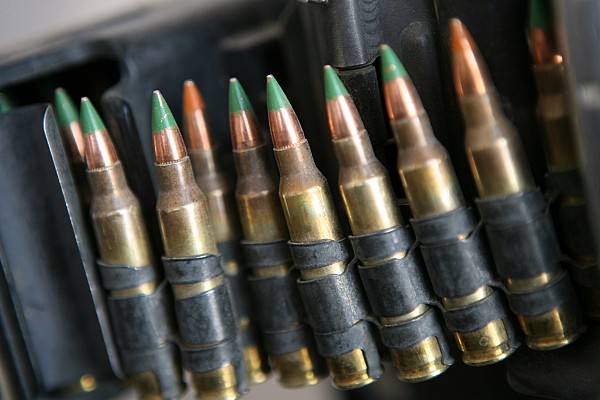
5.56x45mm NATO
A belt of 5.56x45mm NATO rounds. Note the four to one ratio of green tip SS109 to red tip L110 tracer.
Source: US Marine Corps -
© Public domain
Early 1980's (NATO)
Belgium - Fabrique Nationale (NATO)
1984 - present (NATO)
$ 0.30 for M856 in 2005
$ 1.44 for M995 in 2005
Description
Introduction
The 5.56x45mm round is an early Cold War era rifle cartridge of US origin. The civilian designation for the 5.56x45mm round is .223 Remington. The military 5.56x45mm round was developed from the older .222 Remington in the late 1950's by Eugene Stoner for use in his AR-15 assault rifle. Originaly the older .222 Remington round was used in the AR-15, but the US military demanded a slightly heavier bullet which in turn required a larger case. The AR-15 and new bullet were adopted as the M16 and 5.56x45mm M193. In the early 1980's the bullet design was updated by Fabrique Nationale in order to improve the reliability and lethality of the M16. This resulted in the M16A2 and the 5.56x45mm NATO round.
Design
The 5.56x45mm round uses a small spitzer bullet in a bottlenecked rimless brass case. Compared to older rounds such as the 7.62x51mm NATO this results in a much higher velocity, which partially offsets the projectile's limited weight with increased kinetic energy. The 5.56x45mm ammunition is divided into two categories. These are the M193 pattern and NATO pattern ammunition. The older M193 bullets are lighter, have a higher muzzle velocity and require a 1 in 12 inch rifling. The NATO ammunition uses heavier bullets that require a 1 in 7 inch rifling. Ammunition can be interchanged but can result in reduced performance in both cases. Some rifles uses and intermediary 1 in 9 inch twist rate to cater both types of ammunition.
Weapon systems
The rifle that introduced the M193 round was the M16A1, which is also the most produced M193 weapon system. Early versions of the Galil, FAMAS, HK 33 and SG-540 were also chambered for the M193 round. The improved M16A2 and derivatives such as the M4 carbine were among the first weapons to use the NATO round. Other well known weapons that use the NATO round are the G36, SA80, FNC, HK 416, Tavor and SG-550. The NATO round is also used in various light machine guns such as the Minimi, MG4 and Ultimax.
Firepower
The M193 and NATO rounds have a similar accuracy, but the NATO round performs better at longer ranges. The M193 round has a muzzle velocity of 975 m/s and an energy of 1.700 J. At 400 meters these figures are reduced to 520 m/s and less than 500 J. The NATO round has a muzzle velocity of 930 m/s and an energy of 1.700 J. At 400 meters these figures as reduced to 575 m/s and 650 J. At ranges up to 125 m the NATO round is certain to fragment and is considered potentially more lethal than the larger and heavier 7.62x39mm Soviet round. At ranges over 200 meters the NATO round is known to be less lethal than heavier rounds. The standard NATO round will penetrate 3.5mm mild steel at over 600 meters.
Users
The original M193 round was extensively used by the USA during the Vietnam war. It was also in use with various nations around the world, mostly in South America, Asia and Africa. Notable Western users include France and Israel. Since many weapons chambered for the M193 round remain in use outside the USA the M193 ammunition also remains in production. The NATO version of the 5.56x45mm round is in widespread use around the world. It is not only the most widely used round by NATO forces it is also actively used in the Middle East, Asia, South America and Africa.
5.56x45mm M193
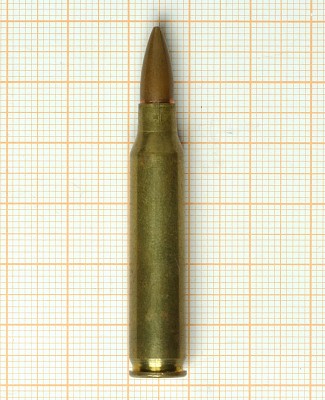
5.56x45mm M193
Detail view of 5.56x45mm M193 cartridge.
Source: Grasyl -
© CC BY-SA 4.0
The original 5.56x45mm round was designed in the United States and is known as the M193 family. This round was used in the early version of the M16 assault rifle and various other weapons. Compared to the improved NATO round it has a lighter bullet, uses a more fouling propellant, has a higher muzzle velocity and uses a longer rifling twist rate. Ammunition of the M193 pattern is or was produced in many nations.
5.56x45mm NATO
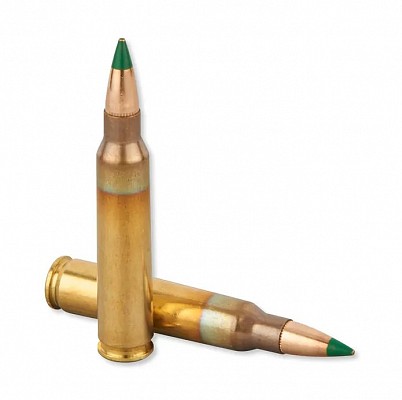
5.56x45mm NATO
Close-up of two 5.56x45mm NATO type SS109 / M855 rounds.
Source: www.aresmaxima.com -
© Copyright lies with original owner
The 5.56x45mm NATO round is an improved version of the M193 round that was developed in Belgium. Compared to the older M193 the SS109 uses a heavier and more effective bullet, uses a cleaner propellant, has a lower muzzle velocity and uses a faster rifling twist rate. The NATO standard FMJ round achieves best accuracy with a 1 in 9 inch rifling, although a 1 in 7 inch rifling is most common since that is required to stabilize the tracer version.
NATO standard SS109 equivalent ammunition is produced in the USA as the M855 (ball) and M856 (tracer), in Canada as the C77 (ball), C78 (tracer) and C79 (blank), in France as the ON (ball) and TN (tracer), in Greece as the GRM562 (tracer) and GRM563 (ball), in South Korea as the K100 (ball) and K101 (tracer), in the United Kingdom as the L1A1 (blank), L2A1 (tracer) and L15A1 (ball) and in various other nations under designations similar as those already described.
5.56x45mm Enhanced Performance
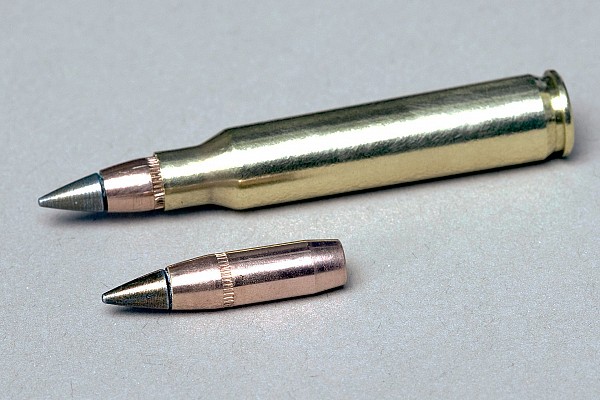
5.56x45mm M855A1 EPR
5.56x45mm M855A1 Enhanced Performance Round with the stacked cone penetrator bullit design shown alonside.
Source: US Army -
© Public domain
The United States has developed several enhanced performance 5.56x45mm NATO rounds to improve performance at both short range and long range. These rounds are optimized to be fired from carbine length and even shorter barrels. Whereas, the NATO rounds were intended to be primarily fired from rifle length barrels.
Related articles
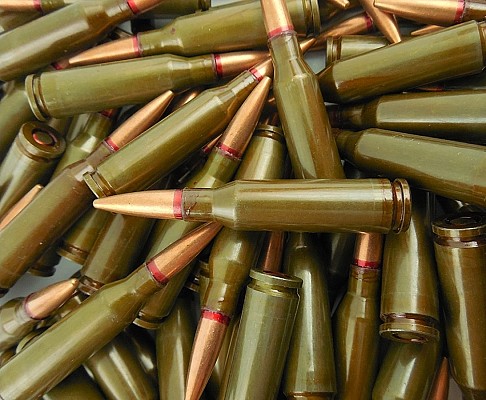
5.45x39mm Soviet
Soviet counterpart to the 5.56mm is the 5.45x39mm Soviet, developed by necking down the 7.62x39mm cartridge.